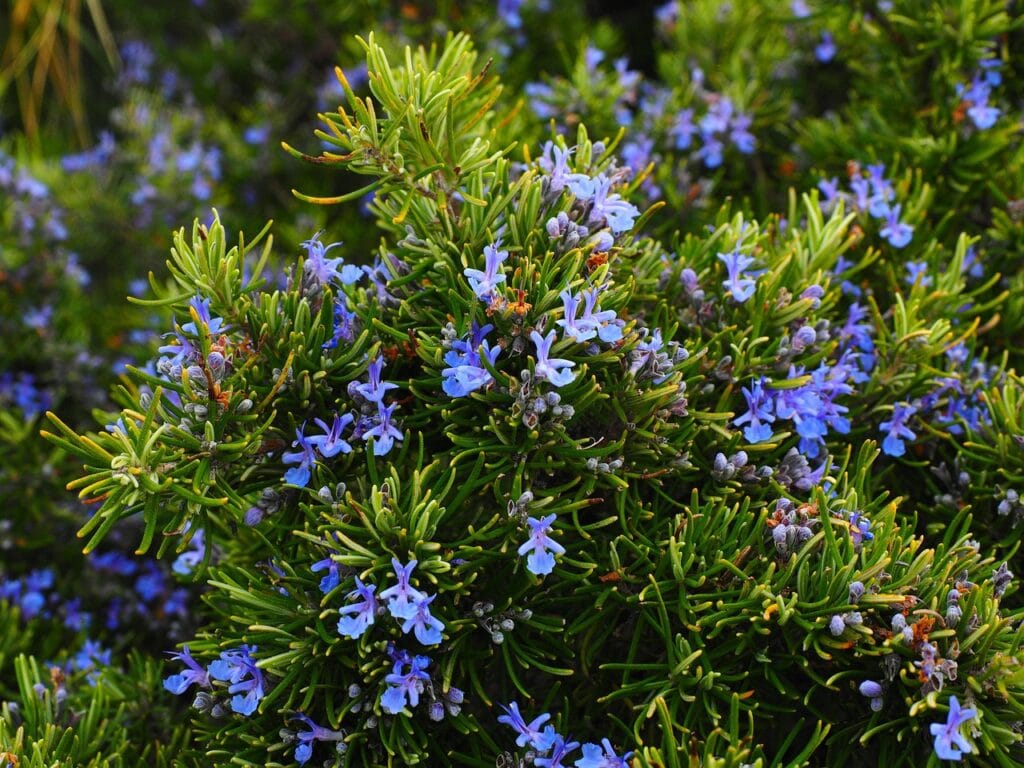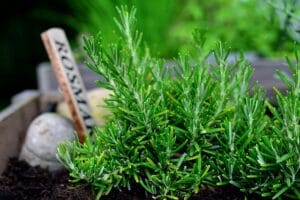How to Grow Rosemary Plant at Home: A Complete Guide
Introduction
In today’s urban India, an increasing number of people are turning to kitchen gardening for fresh, chemical-free herbs right at their doorstep. One such aromatic herb that’s not only flavorful but also medicinal is Rosemary (Rosmarinus officinalis). Native to the Mediterranean, rosemary is a hardy, evergreen herb that thrives surprisingly well in Indian conditions when cared for properly.
Whether you’re an apartment dweller with a small balcony or someone with a terrace garden, growing rosemary at home in India is both satisfying and easy.
| Attribute | Details |
| Common Name | Rosemary |
| Botanical Name | Rosmarinus officinalis |
| Plant Type | Woody Perennial Herb |
| Ideal Climate | Mild winters, warm sunny summers |
| Sunlight Requirement | Full Sun (6-8 hrs) |
| Soil Type | Well-drained, sandy or loamy soil |
| Watering Needs | Low – Water only when soil is dry |
| Best for | Pots, Balconies, Kitchen Gardens |
Rosemary Plant Benefits
- Culinary Uses: Perfect for seasoning Indian and continental dishes.
- Medicinal Properties: Helps with digestion, boosts memory, and relieves stress.
- Natural Repellent: Keeps mosquitoes and some pests away.
- Low Maintenance: Requires little water and care once established.
- Cost Saving: Avoid spending on store-bought herbs.
Choosing the Right Location
Rosemary thrives in sunny locations. In India, most parts receive ample sunlight, which is ideal for rosemary.
Best locations:
- South or west-facing balcony
- Terrace garden
- Kitchen window with direct sunlight
Avoid:
- Shady areas with less than 4 hours of sunlight
- Waterlogged locations
Pot or Ground – Where Should You Plant It
Rosemary grows equally well in the ground or containers, depending on your space.
For Container Gardening:
- Use an 8-12-inch-deep pot with good drainage.
- Add pebbles or broken clay at the bottom for better airflow.
For Ground Planting:
- Choose a raised bed or a sunny corner with well-draining soil.
- Avoid heavy clay soil unless amended with sand and compost.
Best Soil Mix for Rosemary in the Indian Climate
Rosemary dislikes soggy roots. For Indian gardeners, the ideal soil mix is:
DIY Potting Mix:
- 40% garden soil (loamy)
- 30% coarse sand or perlite (for drainage)
- 20% compost (vermicompost or cow dung)
- 10% cocopeat (optional, for moisture retention)
Tip: Avoid using only cocopeat or clayey soil, as they retain too much water.
How to Propagate Rosemary at Home
Propagating rosemary at home is simple and cost-effective. The best method is using stem cuttings. Take a healthy 4–6 inch cutting from an existing rosemary plant, strip the lower leaves, and dip the cut end in rooting hormone (optional). Plant it in a pot filled with moist, well-draining soil. Place the pot in a bright, indirect light area and mist regularly to maintain humidity. Roots typically develop within 2–3 weeks. Once rooted, transplant the cutting to a larger pot or garden bed. This method ensures faster growth and preserves the exact flavor and aroma of the parent plant
Sunlight Requirements
Rosemary thrives in full sunlight and needs at least 6 to 8 hours of direct sunlight daily to grow healthy and aromatic. In India, placing the plant on a sunny balcony, terrace, or windowsill works best. Insufficient sunlight can lead to leggy growth and reduced flavor. Ensure maximum exposure, especially during winter and monsoon seasons.
Watering
Rosemary prefers dry conditions and is highly drought-tolerant once established. Overwatering is a common mistake that can lead to root rot. Always check the top inch of soil before watering—if it feels dry, it’s time to water. In Indian summers, watering once every 2–3 days is usually enough, while in winter, once a week suffices. Ensure pots have proper drainage to avoid waterlogging. It’s better to underwater rosemary than to keep the soil constantly moist.
Tip: Stick your finger into the soil – if it’s moist, skip watering.
Pruning & Maintenance
Pruning is essential to keep your rosemary plant healthy, bushy, and flavorful. Regularly trim the top 2–3 inches of new growth to encourage branching. Begin pruning once the plant reaches about 6 inches tall. Avoid cutting more than one-third of the plant at a time. Remove any yellow or dried leaves to improve air circulation and prevent disease. Routine maintenance also includes checking for pests and avoiding overwatering, especially during the monsoon season in India.
Also, remove dried or yellow leaves to keep the plant tidy.
How to Identify Rosemary Plant
The rosemary plant is a woody, evergreen herb with thin, needle-like leaves that resemble pine needles. These leaves are dark green on top and silvery-white underneath, with a strong, aromatic fragrance when crushed. The plant grows upright and can reach up to 3–4 feet in height. It often produces small, light blue or purple flowers, especially in spring. Rosemary’s distinctive scent and bushy, needle-leaf appearance make it easy to identify among other herbs or garden plants.
Common Pests & Problems
Rosemary is mostly pest-free, but in humid Indian conditions, watch out for:
| Problem | Symptoms | Solution |
| Aphids | Sticky leaves | Spray neem oil (weekly) |
| Powdery mildew | White powder on leaves | Reduce watering, improve airflow |
| Root rot | Yellowing leaves, wilting | Ensure well-draining soil, reduce water |
Neem oil or garlic-chili spray works wonders for most issues.
How to Take Care of Rosemary Plant
To take care of a rosemary plant, ensure it gets 6–8 hours of direct sunlight daily. Plant it in well-draining soil—a mix of garden soil, sand, and compost works best. Water sparingly, only when the top inch of soil feels dry, as rosemary dislikes soggy roots. Regularly prune the plant to encourage bushy growth and remove dead or yellowing leaves. Protect it from excess humidity and pests by providing good air circulation and using organic neem spray if needed. During monsoons, keep the pot under a shelter to avoid overwatering. With minimal care, rosemary thrives beautifully in Indian homes.
When & How to Harvest Rosemary
You can begin harvesting rosemary once the plant reaches 6 to 8 inches in height. The best time to harvest is in the morning after the dew has dried but before the heat of the day. Use clean scissors or garden shears to snip 2–3 inches from the stem, just above a leaf node. Avoid harvesting more than one-third of the plant at a time to ensure healthy regrowth. Regular, gentle harvesting encourages bushier and more productive growth.
How to Dry and Store Rosemary
Drying Method:
- Tie harvested sprigs into bundles.
- Hang upside down in a dry, shady area for 7–10 days.
- Alternatively, use a microwave or dehydrator.
Storage:
- Store dried rosemary in airtight glass jars.
- Keep in a cool, dark place for up to 6 months.
Pink Rosemary Plant
The pink rosemary plant is a charming variety of the traditional rosemary herb, known for its soft pink flowers that bloom in contrast to its aromatic, needle-like green leaves. Unlike the common blue-flowered rosemary, this variety adds a splash of delicate color to herb gardens, borders, and containers. It thrives in full sunlight, well-drained soil and requires minimal maintenance. In addition to its culinary and medicinal benefits, pink rosemary is highly attractive to pollinators like bees and butterflies.
Rosemary Varieties Suitable for India
India’s diverse climate supports several rosemary varieties. The most popular is ‘Tuscan Blue’, known for its upright growth and strong aroma, ideal for pots and hedges. ‘Prostratus’ is a trailing type, perfect for hanging baskets or ground cover. ‘Blue Spires’ offers a bushy look with deep blue flowers, suitable for garden beds. These varieties thrive in Indian conditions with full sun and well-drained soil, making them excellent choices for home gardeners across the country.
Uses of Rosemary in Indian Homes
- Cooking: Use in biryanis, grilled dishes, soups, chutneys
- Herbal oil: Infuse in coconut oil for hair growth
- Aromatherapy: Boil sprigs for a refreshing room fragrance
- Tea: Aids digestion and relieves stress
FAQs – Frequently Asked Questions
Q1. Can rosemary survive the Indian summer?
Yes, rosemary loves heat and sun, but it may need some afternoon shade in extreme heat.
Q2. Is rosemary a seasonal plant?
No, it is a perennial herb and can live for years with proper care.
Q3. Can I grow rosemary from dried store-bought stems?
No, dried stems won’t sprout. Use fresh cuttings or nursery plants.
Q4. Does rosemary attract mosquitoes?
No, it repels mosquitoes due to its strong aroma.
Q5. How long does rosemary take to grow fully?
It takes about 3-4 months to establish and start producing harvestable stems.
Conclusion
Growing rosemary at home in India is not only easy but also highly rewarding. Whether you’re a beginner or an experienced gardener, this fragrant herb adds a delightful aroma, taste, and aesthetic to your home garden.







